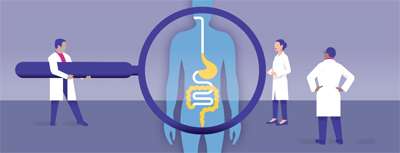Anorectal
Find your care
Proper diagnosis and treatment of GI motility disorders can significantly improve your health and quality of life. Call 310-825-2631 to connect with a specialist.
At UCLA we offer a variety of diagnostic anorectal studies from manometric testing to imaging studies that include x-ray, ultrasound, or magnetic resonance.
Anorectal biofeedback

Anorectal biofeedback is used to treat patients with constipation related to disordered defecation (difficulty pushing a bowel movement out) or formed stool fecal incontinence (difficulty holding in a bowel movement until a bathroom is available). During biofeedback, visual cues are used to assist patients with recognizing how to isolate and coordinate pelvic floor muscles to either push out or hold in a bowel movement.
Before starting biofeedback, you must have completed anorectal manometry diagnostic testing, so that the session can be tailored to meet your needs. Your doctor can order this test for you.
Anorectal biofeedback is not appropriate for patients 8 years old or younger, who are pregnant or who have one or more of the following:
- Known anal strictures or obstructions preventing insertion of the instrument
- Rectal prolapse
- Severe anal pain
- Spinal cord injury
- Severe internal anal sphincter injuries resulting in absence of resting anal canal pressure
- Dementia
- Developmental disability
- Uncontrolled psychotic disorder
- Visual impairment
At the appointment, you will be asked to change into a hospital gown. A nurse will explain the procedure to you and answer any questions you might have. The session will be conducted by the nurse, and there will be a chaperone present due to the sensitive nature of the procedure. First, you will be asked to lie on your left side, so that a small, flexible tube or catheter with an inflatable balloon at the tip can be inserted into the anal canal. The catheter is about the width of an oral thermometer. With the catheter in place, the nurse will instruct you to relax, squeeze, and/or push out at various times to take some measurements that will help guide the rest of the session. The balloon on the catheter will be inflated in the rectum to check sensation. If indicated, you will also complete sensory retraining exercises. Once your session is complete, the balloon will be deflated and the catheter will be carefully removed. After the session, you may drive yourself home and go about your normal activities. The appointment lasts about 60 minutes. Your results will be interpreted by gastroenterologists who have expertise in diagnosing and treating gastrointestinal motility disorders.
Anorectal biofeedback is used to treat: Pelvic floor dyssynergia and fecal incontinence.
Your physician may order one of the following tests. Download prep instructions
- Anorectal biofeedback
Anorectal manometry
Anorectal manometry is a test performed to evaluate patients with constipation or fecal incontinence. This test measures the pressures of the anal sphincter muscles, the sensation in the rectum, and the neural reflexes that are needed for normal bowel movements.
You will be asked to change into a hospital gown. A nurse will explain the procedure to you and answer any questions you might have. The test will be performed by the nurse, and there will be a chaperone present due to the sensitive nature of the test. You will be asked to lie on your left side. A small, flexible tube with an inflatable balloon at the tip will be inserted into the rectum. The tube is about the size of a thermometer. The tube has sensors on it to detect pressure. With the tube in place, the nurse will instruct you to squeeze, relax, and push or bear down at various times. The pressures produced by anal sphincter muscles are measured during each of these maneuvers. The small balloon attached to the catheter will be inflated in the rectum to assess the normal reflex pathways. After this has been done, the tube will be removed and replaced with a balloon that will be filled with some water. You will be asked to expel the balloon as if it were a bowel movement. If you are unable to do so, it will be deflated and carefully removed by the nurse. Once this has been completed, you may drive yourself home and go about your normal activities. The test takes about 30 minutes to complete. The study is interpreted by gastroenterologists who have expertise in diagnosing and treating gastrointestinal motility disorders.
Anorectal manometry is used to diagnose or evaluate: Pelvic floor dyssynergia, constipation, fecal incontinence, and Hirschsprung disease.
Your physician may order one of the following tests. Download prep instructions
- Anorectal manometry
Endoanal ultrasound
This is a test performed by interventional endoscopy services. An interventional endoscopist conducts the ultrasound using a special probe that is inserted into the rectum. This allows the doctor to visualize the anatomy of the anal sphincter muscles.
Endoanal ultrasound is used to diagnose or evaluate: anatomy of the anal canal, fecal incontinence, and rectal sphincter injury.
If this test has been ordered by your gastroenteologist, and you have questions about how to schedule or prepare for your appointment, please speak with your doctor's office.
Defecography
This test is performed by the Radiology Department. It can be performed with x-ray or magnetic resonance. During this test, barium or gel is injected into the rectum and then images are taken as you push the barium out like you would a bowel movement. It allows the radiologist to visualize any changes in the anatomy or function during the procedure.
Defecography studies are used to diagnose or evaluate: Pelvic floor dyssynergia, changes in anatomy or function during defecation (having a bowel movement), rectal prolapse, and intussusception.
If this test has been ordered by your gastroenteologist, and you have questions about how to schedule or prepare for your appointment, please speak with your doctor's office.